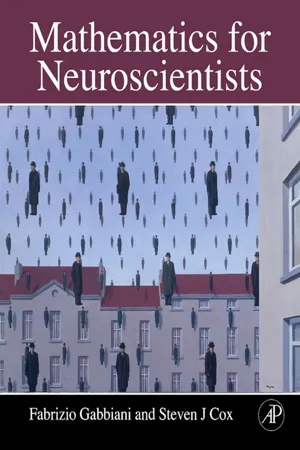
- 498 pages
- English
- ePUB (mobile friendly)
- Available on iOS & Android
Mathematics for Neuroscientists
About this book
Virtually all scientific problems in neuroscience require mathematical analysis, and all neuroscientists are increasingly required to have a significant understanding of mathematical methods. There is currently no comprehensive, integrated introductory book on the use of mathematics in neuroscience; existing books either concentrate solely on theoretical modeling or discuss mathematical concepts for the treatment of very specific problems. This book fills this need by systematically introducing mathematical and computational tools in precisely the contexts that first established their importance for neuroscience. All mathematical concepts will be introduced from the simple to complex using the most widely used computing environment, Matlab.This book will provide a grounded introduction to the fundamental concepts of mathematics, neuroscience and their combined use, thus providing the reader with a springboard to cutting-edge research topics and fostering a tighter integration of mathematics and neuroscience for future generations of students.- A very didactic and systematic introduction to mathematical concepts of importance for the analysis of data and the formulation of concepts based on experimental data in neuroscience- Provides introductions to linear algebra, ordinary and partial differential equations, Fourier transforms, probabilities and stochastic processes- Introduces numerical methods used to implement algorithms related to each mathematical concept- Illustrates numerical methods by applying them to specific topics in neuroscience, including Hodgkin-Huxley equations, probabilities to describe stochastic release, stochastic processes to describe noise in neurons, Fourier transforms to describe the receptive fields of visual neurons- Allows the mathematical novice to analyze their results in more sophisticated ways, and consider them in a broader theoretical framework
Frequently asked questions
- Essential is ideal for learners and professionals who enjoy exploring a wide range of subjects. Access the Essential Library with 800,000+ trusted titles and best-sellers across business, personal growth, and the humanities. Includes unlimited reading time and Standard Read Aloud voice.
- Complete: Perfect for advanced learners and researchers needing full, unrestricted access. Unlock 1.4M+ books across hundreds of subjects, including academic and specialized titles. The Complete Plan also includes advanced features like Premium Read Aloud and Research Assistant.
Please note we cannot support devices running on iOS 13 and Android 7 or earlier. Learn more about using the app.
Information
Table of contents
- Cover image
- Title page
- Table of Contents
- Copyright
- Preface
- Chapter 1: Introduction
- Chapter 2: The Passive Isopotential Cell
- Chapter 3: Differential Equations
- Chapter 4: The Active Isopotential Cell
- Chapter 5: The Quasi-Active Isopotential Cell
- Chapter 6: The Passive Cable
- Chapter 7: Fourier Series and Transforms
- Chapter 8: The Passive Dendritic Tree
- Chapter 9: The Active Dendritic Tree
- Chapter 10: Reduced Single Neuron Models
- Chapter 11: Probability and Random Variables
- Chapter 12: Synaptic Transmission and Quantal Release
- Chapter 13: Neuronal Calcium Signaling*
- Chapter 14: The Singular Value Decomposition and Applications*
- Chapter 15: Quantification of Spike Train Variability
- Chapter 16: Stochastic Processes
- Chapter 17: Membrane Noise*
- Chapter 18: Power and Cross Spectra
- Chapter 19: Natural Light Signals and Phototransduction
- Chapter 20: Firing Rate Codes and Early Vision
- Chapter 21: Models of Simple and Complex Cells
- Chapter 22: Stochastic Estimation Theory
- Chapter 23: Reverse-Correlation and Spike Train Decoding
- Chapter 24: Signal Detection Theory
- Chapter 25: Relating Neuronal Responses and Psychophysics
- Chapter 26: Population Codes*
- Chapter 27: Neuronal Networks
- Chapter 28: Solutions to Selected Exercises
- References
- Index